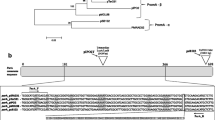Abstract
This work investigated the capability of the conjugative transfer of epsilon-caprolactam biodegradation (CAP) plasmids, belonging to incompatibility (Inc) groups P-2, P-7, P-9, and IncP-9 naphthalene biodegradation (NAH) plasmids to various species of Pseudomonas bacteria, including strains of plant growth-promoting rhizobacteria (PGPR), and the character of plasmid inheritance in these strains. The frequency of the conjugative transfer of all CAP and NAH plasmids (irrespective of their Inc groups) into Pseudomonas PGPR was shown to be lower than that into P. putida soil strains by more than an order of magnitude. The low frequency of conjugative transfer was found not to be caused by secretion of antibiotically active metabolites by Pseudomonas PGPR strains. Stability of inheritance of catabolic plasmids under nonselective conditions was established to depend on their Inc group and bacterial host strain. Thus, all investigated plasmids were stably maintained in P. putida KT2442 and BS394 strains for at least 100 generations. However, only CAP plasmids of IncP-2 and IncP-7 groups were stably maintained in Pseudomonas PGPR cells. CAP and NAH plasmids of different IncP-9 subgroups were eliminated from cells of rhizosphere pseudomonads within several generations. Thus, the work first revealed inheritance features of IncP-9 catabolic plasmids in Pseudomonas PGPR cells.

Similar content being viewed by others
REFERENCES
Gupta, G., Parihar, S.S., Ahirwar, N.K., and Snehi, K.S., Plant growth promoting rhizobacteria (PGPR): current and future prospects for development of sustainable agriculture, J. Microb. Biochem. Technol., 2015, vol. 7, pp. 96—102.
Siunova, T.V., Anokhina, T.O., Sizova, O.I., and Kochetkov, V.V., Impact of plant growth promoting rhizobacteria Pseudomonas in phytoremediation process, in Handbook of Phytoremediation, Golubev, I.A., Ed., New York: Nova Science, 2011, pp. 551—572.
Timmis, K.N., Pseudomonas putida: a cosmopolitan opportunist par excellence, Environ. Microbiol., 2002, vol. 4, no. 12, pp. 779—781.
Smalla, K., Jechalke, S. and Top, E.M., Plasmid detection, characterization and ecology, Microbiol. Spectr., 2015, vol. 3, no. 1. https://doi.org/10.1128/microbiolspec.PLAS-0038-2014
Sevastsyanovich, Y.R., Krasowiak, R., Bingle, L.E.H., et al., Diversity of IncP-9 plasmids of Pseudomonas,Microbiology, 2008, vol. 154, pp. 2929—2941.
Boronin, A.M. and Kosheleva, I.A., The role of catabolic plasmids in biodegradation of petroleum hydrocarbons, in Current Environmental Issues and Challenges, Cao, G. and Orru, R., Springer-Verlag, 2014, p. 159—168. https://doi.org/10.1007/978-94-017-8777-2-9.
Izmalkova, T.Yu., Sazonova, O.I., Sokolov, S.L., et al., The P-7 incompatibility group plasmids responsible for biodegradation of naphthalene and salicylate in fluorescent pseudomonads, Microbiologyia, 2005, vol. 74, no. 3, pp. 290—295.
Esikova, T.Z., Grishchenkov, V.G., and Boronin, A.M., Plasmids that control ε-caprolactam biodegradation, Microbiologiya, 1990, vol. 59, pp. 547—552.
Kochetkov, V.V. and Boronin, A.M., Comparative study of plasmids controlling for naphthalene biodegradation by a Pseudomonas culture, Microbiologiya, 1984, vol. 53, no. 4, pp. 639—644.
Chin-A-Woeng, T.F.C., Bloemberg, G.V., van der Bij, A.J., et al., Biocontrol by phenazine-1-carboxamide-producing Pseudomonas chlororaphis PCL1391 of tomato root rot caused by Fusarium oxysporum f. sp. radicis-lycopersici,Mol. Plant Microbe Interact., 1998, vol. 1, pp. 1069—1077.
Mavrodi, D.V., Ksenzenko, V.N., Bonsall, R.F., et al., A seven-gene locus for synthesis of phenazine-1-carboxylic acid by Pseudomonas fluorescens 2-79, J. Bacteriol., 1978, vol. 80, pp. 2541—2548.
Eberl, L., Schulze, R., Ammendola, A., et al., Use of green fluorescent protein as a marker for ecological studies of activated sludge communities, FEMS Microbiol. Lett., 1997, vol. 149, pp. 77—83.
Sagai, H., Hasuda, K., Iyobe, S., et al., Classification of R plasmids by incompatibility in Pseudomonas aeruginosa,Antimicrob. Agents Chemother., 1976, vol. 10, pp. 573—578.
Esikova, T.Z., Ponamoreva, O.N., Baskunov, B.P., et al., Transformation of low-molecular linear caprolactam oligomers by caprolactam-degrading bacteria, J. Chem. Technol. Biotechnol., 2012, vol. 87, pp. 1284—1290.
Dunn, N.W. and Gunsalus, I.C., Transmissible plasmids coding early enzymes of naphthalene oxidation in Pseudomonas putida,J. Bacteriol., 1973, vol. 114, pp. 974—997.
Author information
Authors and Affiliations
Corresponding author
Ethics declarations
The authors declare that they have no conflict of interest. This article does not contain any studies involving animals or human participants performed by any of the authors.
Rights and permissions
About this article
Cite this article
Esikova, T.Z., Anokhina, T.O., Akhmetov, L.I. et al. Inheritance of IncP-9 Catabolic Plasmids in Pseudomonas Bacteria. Russ J Genet 55, 1569–1572 (2019). https://doi.org/10.1134/S1022795419120032
Received:
Revised:
Accepted:
Published:
Issue Date:
DOI: https://doi.org/10.1134/S1022795419120032




